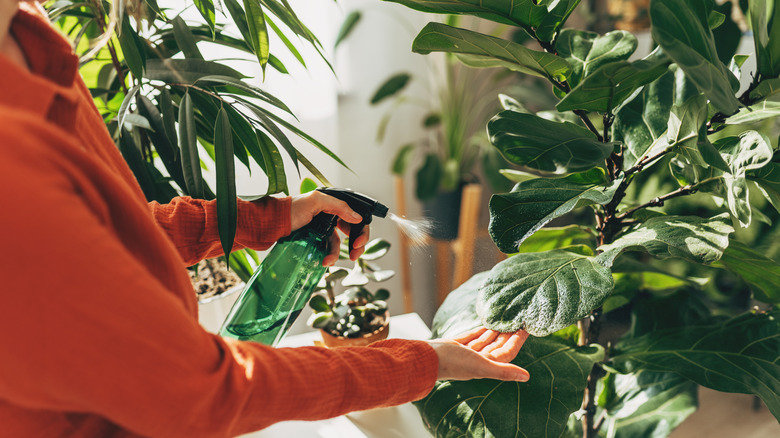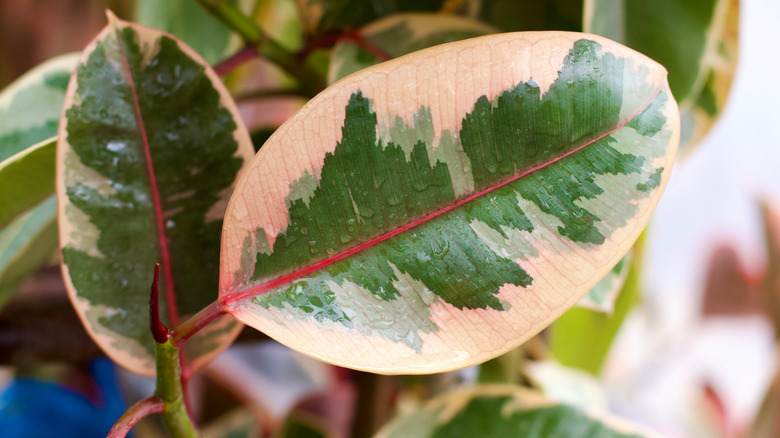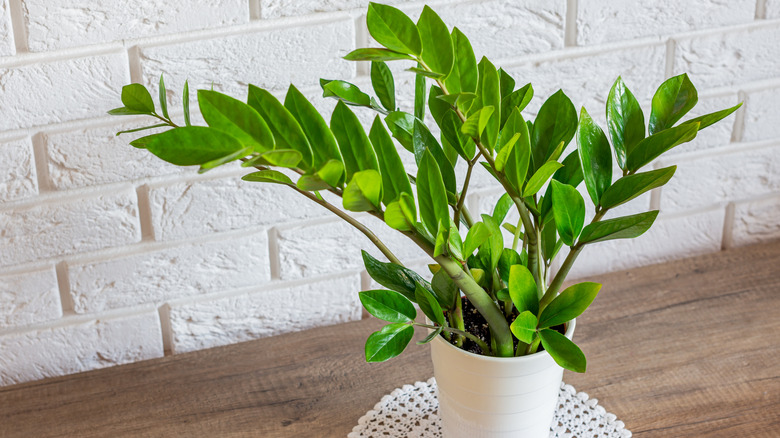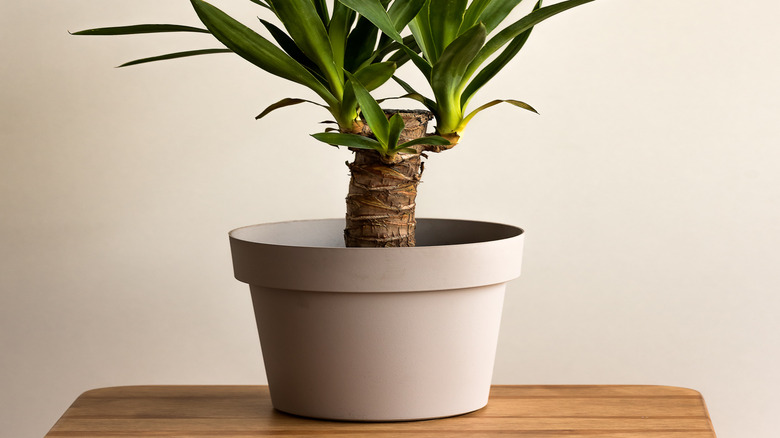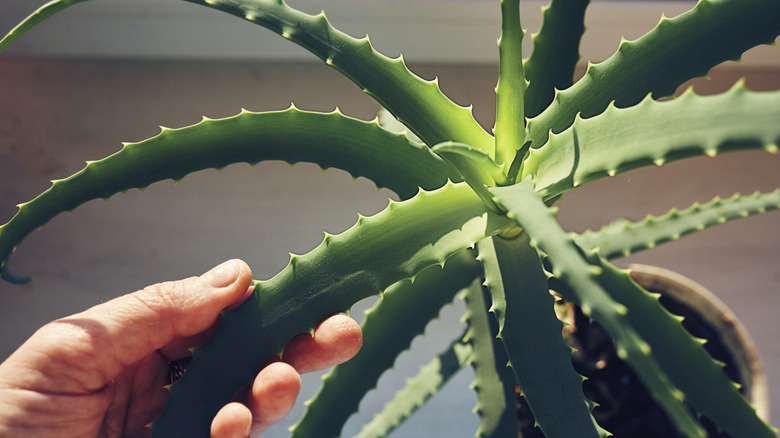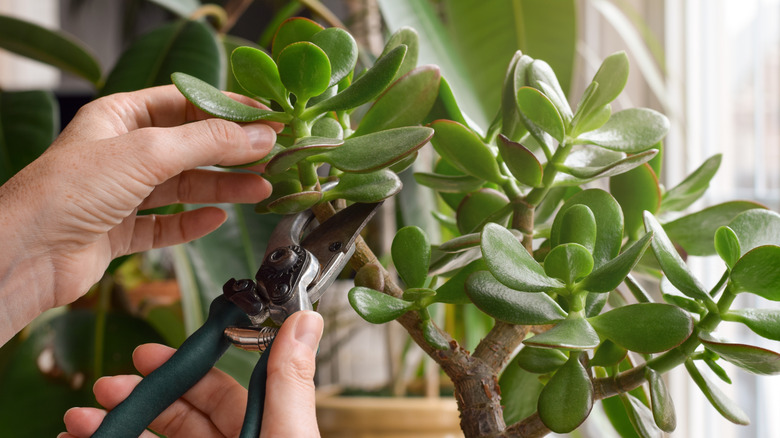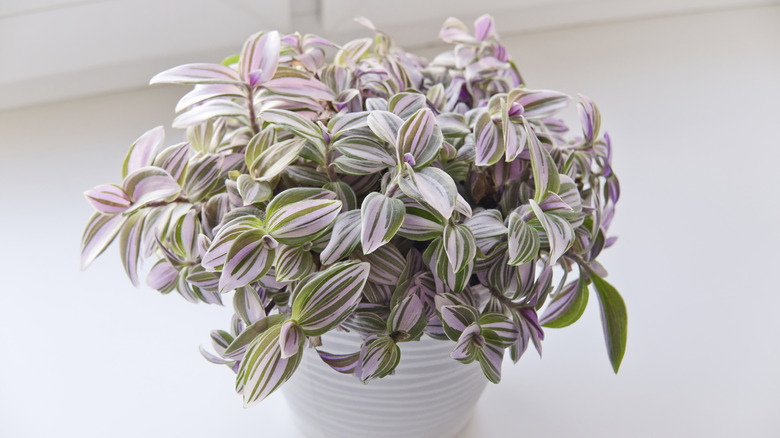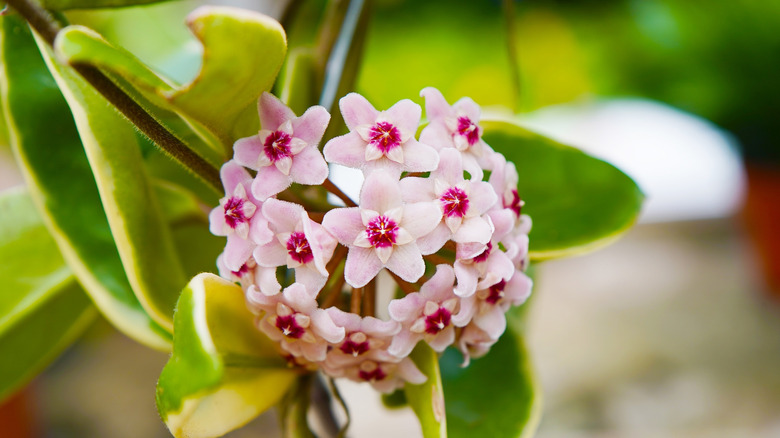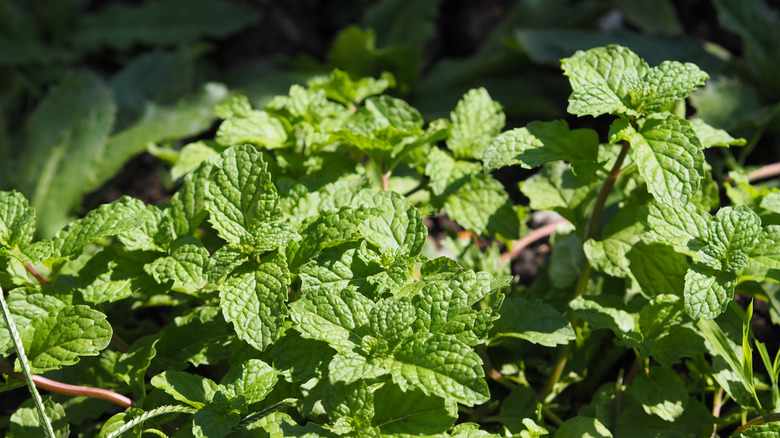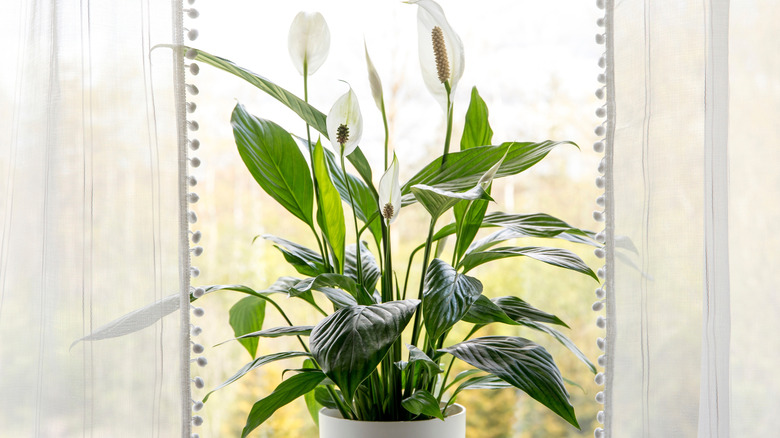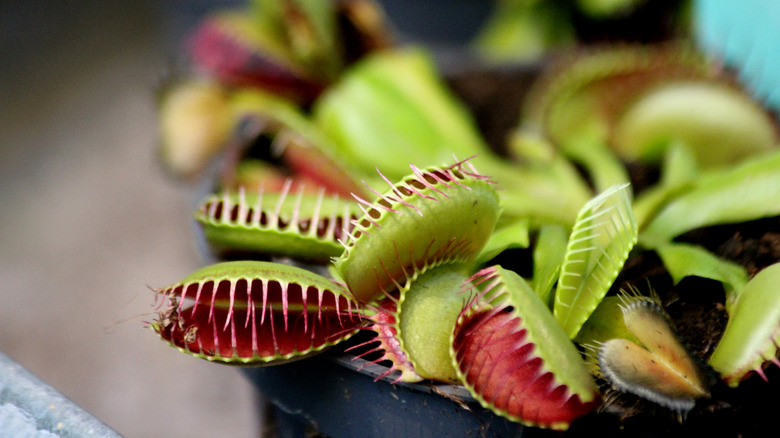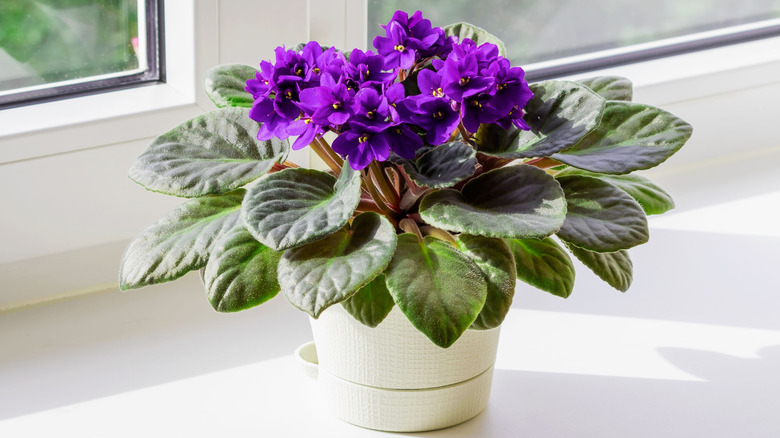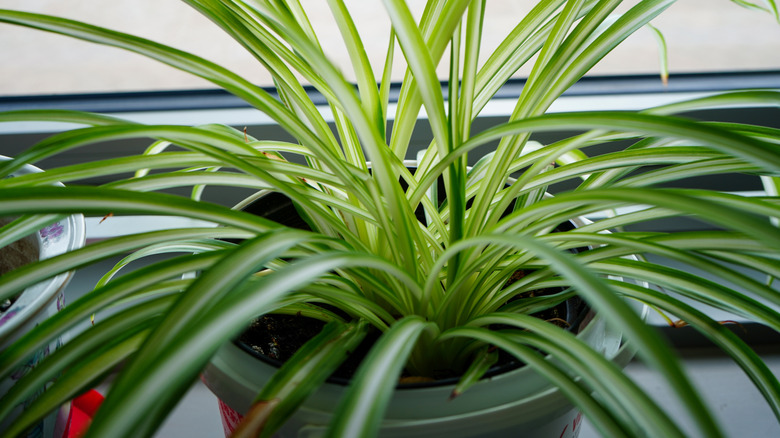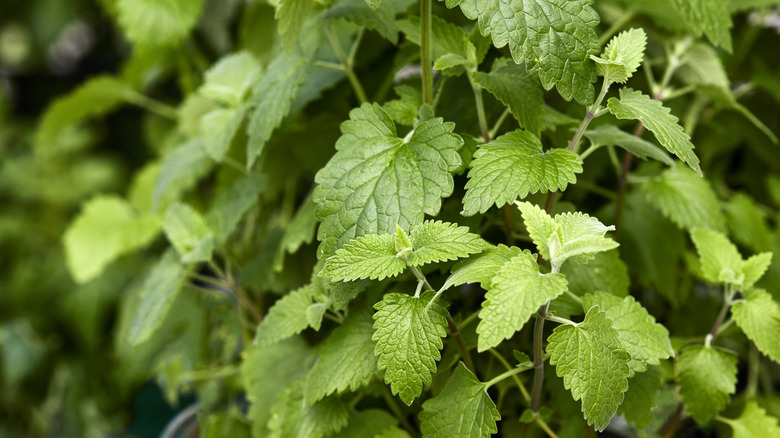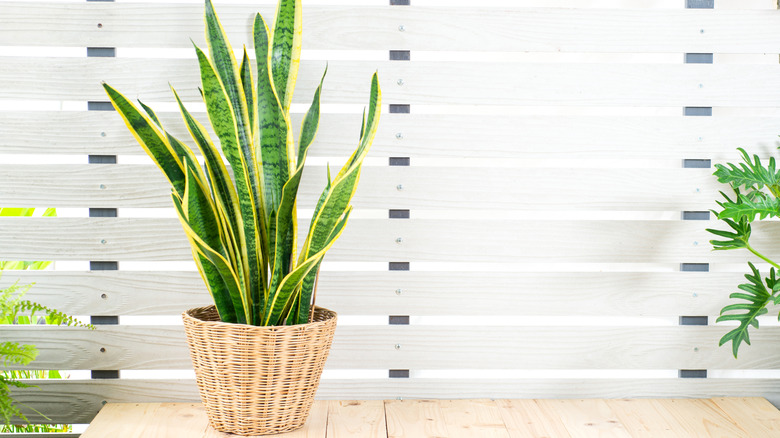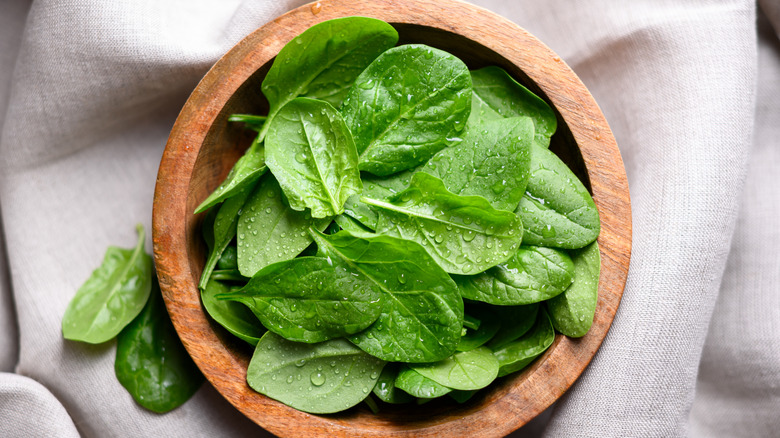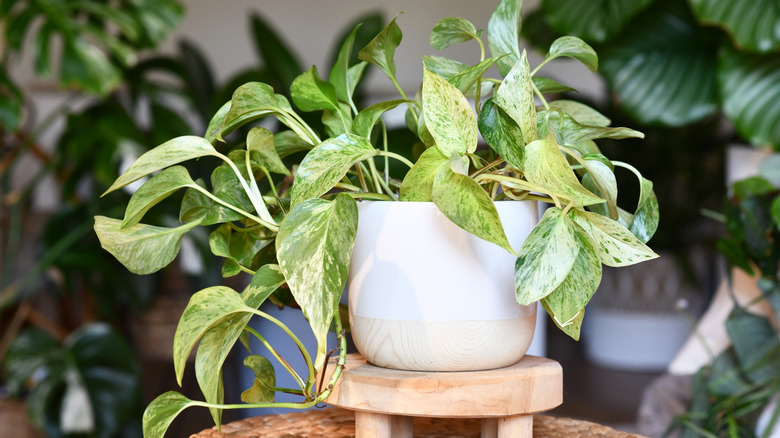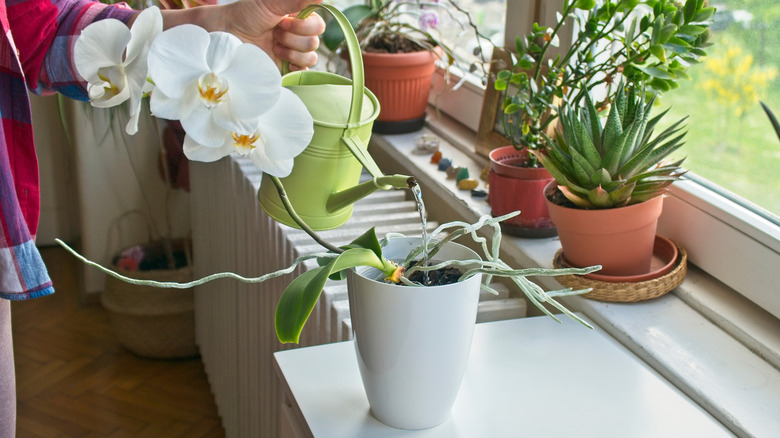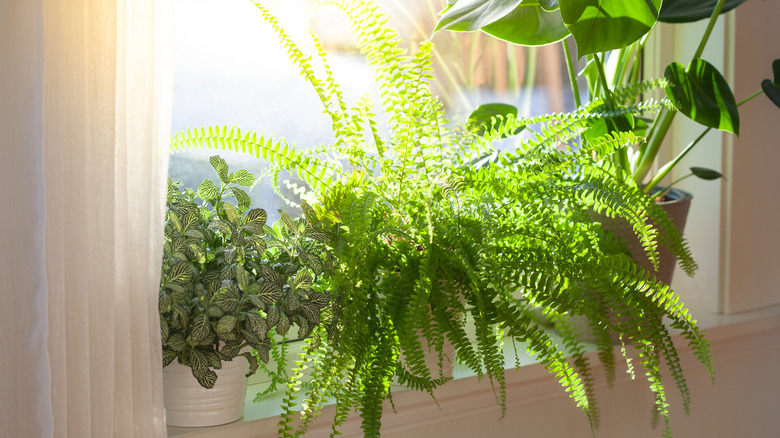20 Houseplants That Will Thrive In Your Sunny Kitchen
While there are plenty of kitchen decor trends that come in and out of the zeitgeist, complete with paint colors, cabinet choices, and even brilliant hacks to make your kitchen more aesthetic, there's no way to know how long any one trend will be around for. If you want to build a kitchen that's timeless, you'll have to look toward evergreen staples that don't go in and out of fashion. And one such category of decor that's always around is houseplants. By finding stunning plants that will thrive in containers in full sun, like ZZ plants and rubber trees, you can build a fresh, green kitchen that your guests will envy.
Choosing the correct houseplants for a given space is somewhat of an easy task, especially when you know the type of sunlight you have in each spot. Plants placed within a windowsill will be getting full sun, meaning they'll be exposed to bright light for five or more hours in the day. That is especially true if the window is facing to the south or west, where your plant will get all of the afternoon sunlight. Plants placed in a north- or east-facing windowsill could potentially get full light or partial light, depending on other factors like the proximity of other buildings and the length of the morning in your location. All of the plants below are perfect houseplants for a kitchen window because they require full or partial-to-full sunlight — keep reading for our suggestions.
Rubber tree
Rubber tree plants (Ficus elastica) have large, waxy, shiny leaves that are often dark green with pink and white spots. These plants do their best in bright, indirect sunlight, but could get burned in too much afternoon sun, so they're best for east- or north-facing kitchen windows. They also love moisture, since they're tropical plants, so a wet, hot kitchen is perfect for them. Be careful not to introduce too many new changes to your plants too quickly — for instance, you should move them in their original containers and give them time to acclimate before repotting.
ZZ plant
The Zamioculcas zamiifolia, aka ZZ plant, is a funky looking houseplant with fun, aesthetically pleasing leaves that splay out from the center stem. This plant is beginner friendly and ideal for just about any type of lighting other than long, direct sunlight (so you should avoid placing it right in a south-facing window.) It's best to dust your ZZ plant regularly, since debris can accumulate on the leaves and prevent the plant from absorbing required sunlight to survive, and you can rotate it to ensure that it grows evenly in all directions.
Yucca cane
The yucca cane plant (Yucca gigantea) is another fun houseplant that thrives in various conditions, but it particularly loves the sun. You can place a yucca cane plant in direct sunlight — yes, even south-facing windows — and watch it grow. This plant is considered particularly easy to grow and care for, only needing fertilization a few times a year and water when the top layer of soil dries out. The yucca cane struggles in dry air, so a moisture-filled kitchen is a great spot for it (otherwise, you can trim the dried, brown leaf edges off when they arise.)
Aloe vera
Have you ever wanted to grow your own skincare solutions? The aloe vera houseplant offers more than just a pop of greenery — you can actually use the gel inside the plant to treat rashes, sunburns, and other ailments. And, what's better is that these plants love bright, indirect sunlight, like what's found in west- and south-facing kitchen windows. While aloe can still grow in lower light, the plant might become to leggy and won't thrive as much as it would in bright light. To avoid root rot, you should let the soil dry out between waterings.
Jade plant
Jade plants, otherwise known as Crassulas, are soft, tall succulents whose leaves grow off of a brownish, trunk-like center stem. As succulents, these plants love light and thrive in environments that emulate the desert. That means windowsills are ideal, as they'll take as much light as they can get. Jade plants would do better with too little water as opposed to too much, so be sure to let the soil dry between waterings to avoid root rot. You can also expect fun colors, like pinks and purples, on different variations of crassulas.
Tradescantia
The purple-y pink and green stripes of Tradescantia make it an appealing and desirable houseplant (that even seems to glimmer in some lighting setups.) This plant requires bright indirect light, like from a window, and can also survive outside in full sun. They also prefer high humidity, and can grow medium to fast based on the variety. Tradescantia is an easy plant to propagate, too, so an investment into one plant could lead to many more in your future if you cut and care for the propagations properly.
Hoya
The hoya plant (Hoya carnosa) is a trending houseplant from 2025 that you don't want to miss out on. Famous for having thick, waxy leaves, hoyas come in many different varieties. One popular type of hoya is the Hoya carnosa, which can even flower regularly, producing beautiful soft pink and white flowers. These plants love bright, indirect lighting, like the light found in a bright kitchen window, and don't require much care other than regular waterings. Just make sure their soil has proper drainage — too much water could cause root rot.
Mint
If you're going to introduce greenery into your kitchen, why not include some edible plants? Mint (Menthe) is a great ingredient for teas, treats, and even savory dishes. Mint is also great option to grow in a kitchen window. This plant can grow in a lot of different environments, from full sun to partial shade, and likes wet soil, but could be damaged by overly wet roots. Mint also grows very quickly, so you can harvest it regularly — just be sure to research the mint plant you've selected to make sure it's the right variety for your culinary taste.
Cilantro
On the topic of kitchen plants you can consume, cilantro (Coriandrum sativum) is another easy-to-grow option that doubles as a beloved seasoning (so long as you don't have the gene that makes the herb taste soapy.) The fresh-tasting herb grows best when it has between six and eight hours of sunlight per day, so you will want to place it in a south- or west-facing kitchen window or add some LED growth lights to supplement if necessary. Temperature control is a big issue for this plant: If the temperature goes above 85, it could bolt and become flavorless.
Peace lily
The elegant, leafy peace lily (Spatiphyllum) is an aesthetic option for adding some height to your houseplant collection. The plant (which is actually not in the lily family, but instead in the Araceae family), often grow between 1 and 4 feet tall, but can sometimes reach heights of 6 feet. They grow in bright, indirect sunlight, but can burn if they receive too much sun, so be sure to keep an eye on your plant. You should also keep this plant away from pets, as the blooming white flowers are toxic when consumed.
Venus fly trap
Introducing the funky, colorful Venus fly trap (Dionaea muscipula) into your houseplant collection can help other plants by reducing the number of pests. That's because these unique plants can trap and consume bugs, which is super convenient in keeping the rest of your plants safe. Although this plant grows better when fed live bugs, you don't need to feed them bugs in order to keep them alive because they still use photosynthesis like other plants. You should keep your Venus fly trap in a bright window and keep it wet with a water tray.
African violet
If you want to add an extra pop of color to your windowsill, the African violet plant (Saintpaulina ionatha) is a great choice. This plant has violet-colored flowers that do well in bright sun, but extreme rays can burn it. You should grow your African violets in a south-facing, bright window for the winter months, then filter the summer sunlight through a curtain or move the plant to a less bright window during the summer. These plants are temperature-sensitive, so you should also pull them 18 inches from a window when it's cold outside to protect them.
Spider plant
The classic spider plant (Chlorophytum comosum) is a trustworthy, durable houseplant that has become quite popular for a reason. In order to help this plant thrive, you can place it in a window that gets medium to bright light and keep it watered (but it's better to under water than over water a spider plant, like with most plants.) When a spider plant is growing, it will produce small offshoots called "pups" or "spiderettes" that you can cut off and propagate to turn into a plant of its own.
Coffee plant
Add color with a beautiful coffee plant (Coffee arabica) that will help you understand the full life cycle of the beloved morning beverage. Unfortunately, you most likely won't be able to make your morning latte with your own home-grown beans unless you invest in a whole bunch of these plants. To care for an indoor coffee plant, you should place it in bright, indirect sunlight — if the leaves start going brown, move it to a lower-sun spot. Water the plant frequently and use a spray bottle to mist it so it gets enough humidity.
Catnip
A cat delicacy, herb, and houseplant all in one, catnip (Nepeta cataria) offers a real trifecta of options. Catnip (not to be confused with cat grass, which looks, as you can imagine, like grass) tends to appear similar to a mint plant, so be sure to label it if you're growing both. This plant needs moderate temperatures and moderate humidity levels, making it well-suited for indoor spaces. Catnip also requires between six and eight hours of direct sunlight per day, but you can supplement that with LED lights if you don't have the right window placement for its growth.
Snake plant
Snake plants (Sansevieria trifasciata) are another popular houseplant that are relatively easy to grow and offer a chic aesthetic with their vertically growing striped leaves. Indoor varieties can sometimes grow up to 3 feet tall, and outdoor snake plants have been known to reach heights of up to 8 feet. To care for a snake plant, place it in indirect light where it can soak up eight to ten hours of sunlight a day. You should only water it when the soil is completely dry, because overwatering can kill the plant.
Spinach
For another edible kitchen plant, you can opt for some nice green spinach (Spinacia oleracea) that will help you infuse your meals with some extra vitamins along the way. You will want to plant your spinach seeds in a big enough container to hold a few starters, which means one about 14 inches in diameter. Spinach can handle less sunlight: It only needs 4 hours of sunlight per day, so could be better for kitchen windows that don't receive as much light, like ones that face other buildings or north-facing windows.
Pothos
Another low-light option is the beloved pothos plant (Epipremnum aureum). This is a great selection if you're just getting started with your own plant collection, as pothos are resilient and need less care than other greenery. Pothos is also known for its long, droopy vines, so you can hang one from your kitchen ceiling to increase space for other plants. To care for a pothos, make sure it's in a well-draining container and in bright, indirect light. Whiter leaves may indicate that your pothos is getting too much light, and dark green leaves indicate the opposite.
Orchid
Orchids make for beautiful houseplants that will provide exciting floral growth when properly cared for. And, if you love the look of them, there's good news: Orchids come in plenty of varieties, and each variety has its own lighting requirements. That means if you have a kitchen that doesn't get as much direct light, you can opt for a low-light orchid like the Paphiopedilum. On the other hand, if your kitchen is super bright (which is indicated by the sun casting hard shadows from the objects in or near the window), you can get something like the Ascocenda orchid.
Ferns
Ferns are beautiful, full-looking green plants that grow all over the world. To bring a fern into your own home, you'll want to find a spot with medium light, like an east-facing window or a spot slightly away from a south- or west-facing window. During the winter, you should move the fern to a higher-light space, like directly in a south- or west-facing window, so that it gets enough light on short days. If you notice signs of burning on the fragile fern leaves, it might be receiving too much sun and should be moved further from the glass.
